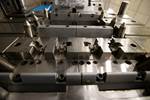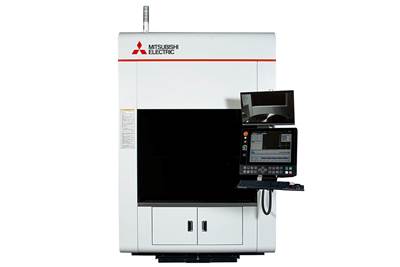EDM, Precision Milling, 3D Printing Improves Accuracy, Reduces Machining Time
IMTS 2024: MC Machinery Systems showcases an array of EDM and precision milling tools, as well as a wire laser metal 3D printer, all of which have the capacity to meet moldmaking needs.
V550 (top left), AZ600 (top right), MV1200R (bottom left) and SV12P (bottom, center). Source (All Images) | MC Machinery Systems Inc.
MC Machinery displays its latest EDM and precision milling technology, including wire and sinker EDMs, machining centers and automation. Also featured is the Mitsubishi AZ600 wire laser metal 3D printer, which melts welding wire with a laser beam to create high-quality 3D structures.
A subsidiary of Mitsubishi Corp., MC Machinery is a North American supplier and servicer of precision machining equipment from Mitsubishi Electric, OPS Ingersoll and Roku-Roku, including wire and sinker EDMs, precision milling machines and automation systems.
MC Machinery’s featured machines include:
Sinker EDMs. With artificial intelligence (AI) adaptive control technology, the Mitsubishi SV12P and SG12 sinker EDMs are designed to optimize performance, improve productivity, reduce electrical consumption and accurately estimate machining time.
The SVP Series features a sensor to monitor the total amount of electrode contact area within the workpiece, enabling the system to automatically change power conditions based on real-time measurement feedback. The company says that, along with producing the most efficient burn, this technology results in up to 40% less electrode wear and an up to 30% reduction in machining time.
At the booth, the SV12P is outfitted with Erowa Robot Compact 80 milling and sinker automation.
Also featured is the OPS Ingersoll Gantry Eagle 800 sinker EDM, which is geared toward large-part and molding applications. Tailored for low electrode wear and fast cycle times, the Gantry Eagle series has on-board components designed to reduce wear and tear, which in turn can decrease maintenance and costly downtime. It also has a large working area that requires minimal floor space.
Wire EDMs. The MV1200-R Mitsubishi wire EDM features the company’s latest machine construction, submerged threading, fiber optic machine communication and power supply technology. This machine is shown with the Mitsubishi Electric six-axis robot automation system.
The MV2400-R Mitsubishi wire EDM is designed for a wide range of applications, with a large tank capacity and low operational costs. The MV-R series features improvements in machine construction, auto-threading, internal machine communication and power supply technology. It also includes a noncontact cylindrical drive system on the X-, Y-, U- and V-axis drives.
The MV4800-S Mitsubishi wire EDM is made for large-part applications up to 20" high (standard), and 32" high (optional) and can perform submerged cutting up to 20" deep. With an annealing length of more than 27", this system is capable of threading through the workpiece both at the start point and through the gap.
The MX600 Oil Advance Plus wire EDM, known for its machining accuracy and surface finish, contains wire capability down to 0.0008″ (0.02 mm) diameter. The MX600 features a nano-pulse power supply and DMX-S super digital control sensor, created to shape each spark, producing surface finishes down to 1.6µ Ra.
Precision milling. Roku HC658II is used for hard milling and electrode manufacturing in the mold industry. This machine is a full-bridge style design, intended for accuracy and hand scraped each way surfaces. It includes a 32,000-rpm spindle and graphite protection.
The Android II linear drive milling machine is a machining center designed for precise hard steel and carbide machining with accuracies within ±1 µm. With a 60,000-rpm spindle, it is said to boost productivity on high-precision jobs and deliver accuracy, quality and speed.
The Ingersoll Eagle V550 graphite machining center is intended for high speed and high precision when manufacturing electrodes. It has a compact design and features five-axis machining for small graphite electrodes and hard machining of mold/die components. It also includes the Heidenhain 640 controller.
Wire metal laser 3D printing. Using commercially available welding wire as the feedstock, the Mitsubishi AZ600 has applications including rapid prototyping, mold and die, one-offs, short runs, mass manufacturing, maintenance, repair, tooling and more.
With the same wire-feeding technology used in Mitsubishi’s wire EDMs, a simple command on the machine’s CNC control feeds the exact amount of wire to the target location. Unlike other 3D printers, the wire is in the front of the machine, designed to make it simpler to replace.
Related Content
MMT Chats: The Connection Between Additive Manufacturing Education and ROI
This MMT Chat continues the conversation with Action Mold and Machining, as two members of the Additive Manufacturing team dig a little deeper into AM education, AM’s return on investment and the facility and equipment requirements to implement AM properly.
Read MorePrecision Meets Innovation at IMTS 2024
After attending IMTS, it's clear that the integration of advanced technologies is ready to enhance precision, efficiency and automation in mold manufacturing processes. It’s a massive event, so here’s a glimpse of what the MMT team experienced firsthand.
Read More3D Printing Technologies for Moldmaking Applications
3D printing technologies, from conformal cooling to complex mold building, are making an impact on the moldmaking industry, one innovation at a time.
Read MoreBuilding Molds: Most Popular Reads of 2024
Dive into the most-viewed content for building your mold, including topics such as cutting tools, EDM, hot runners, additive manufacturing, mold materials, machining and mold components.
Read MoreRead Next
Extensive Evaluations Build The Plastek Group’s EDM Arsenal
Sinker and wire EDMs selected for speed, volumetric accuracy, surface finish, reliability, cost of ownership and extensive warranty.
Read MoreWire-Laser Metal 3D Printer for Efficient, Versatile Processing
The MC Machinery Systems printer applications include rapid prototyping, mold and die, one-offs, short runs, mass manufacturing, maintenance, repair, tooling and more.
Read MoreReasons to Use Fiber Lasers for Mold Cleaning
Fiber lasers offer a simplicity, speed, control and portability, minimizing mold cleaning risks.
Read More

























